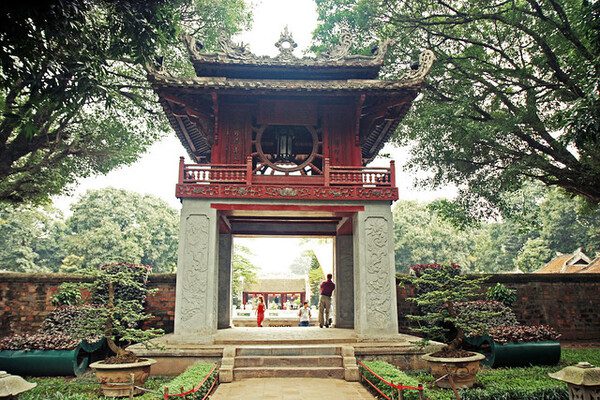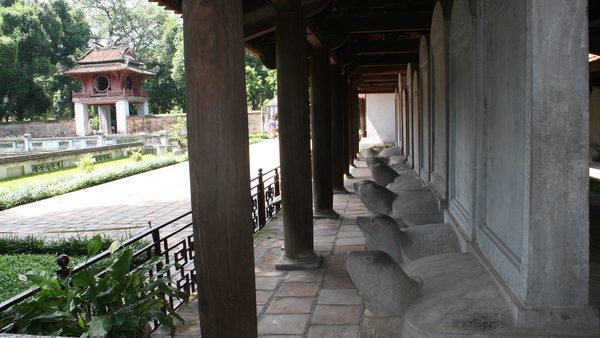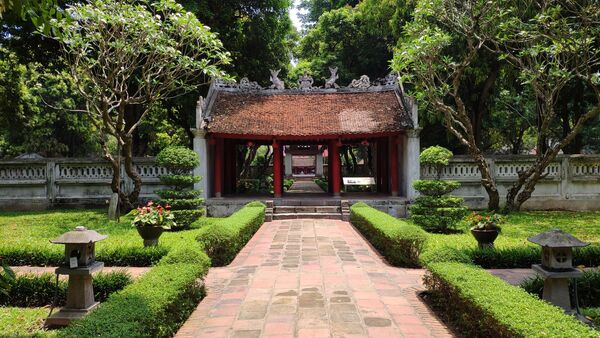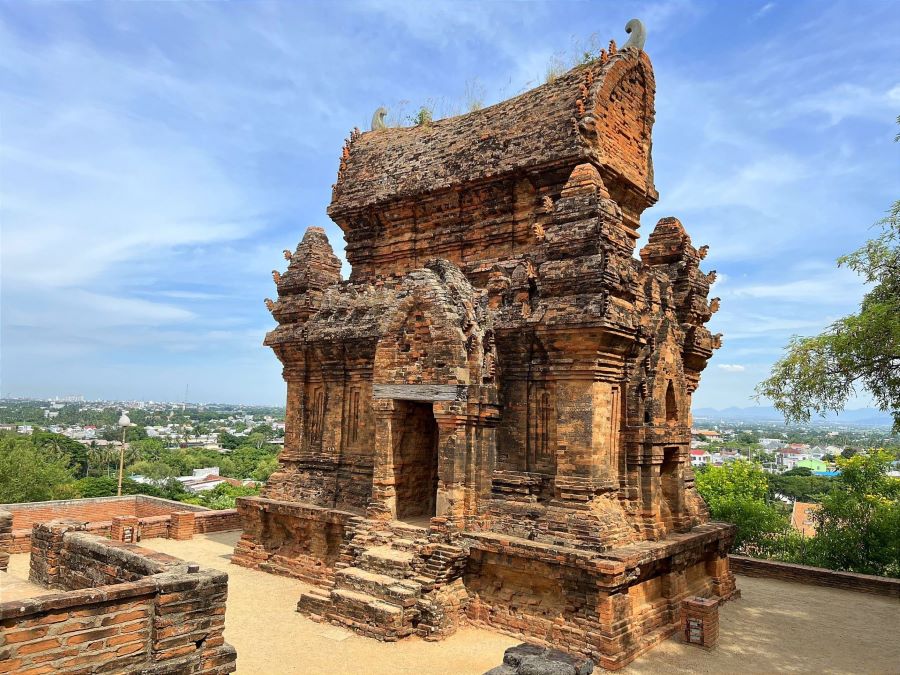Temple of Literature in Hanoi: A visit of serenity and culture
The earliest university in Vietnam is Temple of Literature in Hanoi (Van Mieu Quoc Tu Giam Ha Hoi) . Today, it is a historical-cultural relic visited by many troops and students to pray for luck in studying and taking tests, as well as a popular tourist destination. During your Hanoi city tours, take the time to visit must-see sightseeings. There will be many intriguing things to study and discover. However, because it is a place of worship, there will be severe laws; please review the information below before entering.
About Temple Literature in Hanoi
Temple of Literature is a place that every Vietnamese child is probably familiar with. For a while, this relic was the capital’s pride and a brave tribute to the educational cause.

Khue Van Cac port at Temple Literature in Hanoi
History of Temple of Literature
The Temple of Literature was established in 1070 (during the reign of King Le Thanh Tong) to honor Confucius, Chu Cong, and Tu Ma. King Le Thanh Tong authorized the construction of more Quoc Tu Giam in 1076, near to a school for kings, mandarins, and affluent noble families. It was renamed Quoc Academy in 1253 under the reign of King Tran Thai Tong, allowing commoners’ children to learn successfully. As the post-Le era began, King Le Thanh Tong ordered the construction of steles for people who passed the exam from 1442 forward; there are currently 82 steles remaining.
Address of Temple of Literature
The Temple of Literature is located on Quoc Tu Giam Street in Hanoi’s Dong Da District. It used to belong to Minh Giam village, general Huu Nghiem, and Tho Xuong, but during the French colonial time, it belonged to Thinh Hoa, Yen Ha, Hoang Long, and Ha Dong. It has four main streets on its four sides: Quoc Tu Giam Street (main gate), Nguyen Thai Hoc Street (north), Van Mieu Street (east), and Ton Duc Thang Street (west).
Closing and opening hours of Temple of Literature
Because Temple of Literature has become a popular tourist site, it is open every day of the week, including holidays and Tet, to meet the sightseeing needs of both domestic and foreign tourists. However, the hours of operation are not fixed and may vary depending on the season.
- Day opening time: Monday through Friday: 7:30 a.m. to 18:00 p.m.; Saturday and Sunday: 30 minutes later (i.e. 8 a.m.) and close 3 hours later (21 p.m.).
- Seasonal opening time: During the summer (April 15 to October 15), the Temple of Literature welcomes visitors at 7:30 a.m. and closes at 6 p.m. During the cold season (October 16 to April 14 next year), the Temple of Literature is open from 8am to 6pm
Does Temple of Literature sell tickets to visit?
Many individuals are curious whether the Temple of Literature Hanoi offers tickets. Yes, and the quoted charge is 30,000 VND/time, which applies to both foreign and Vietnamese guests.
Persons with severe disabilities; the elderly; persons from communes and districts in mountainous and isolated areas; people who have made meritorious contributions to the revolution, the Party, and students over the age of 15 will receive a 50% reduction on ticket prices. Tickets are free for children under the age of 15 and those with severe disabilities.
How to go to Temple of Literature?
Visitors can go from the city center to Van Mieu Quoc Tu Giam via bus, taxi, or private vehicle, such as hiring a motorbike in Hanoi. If you travel by bus, select one of the lines 02, 23, 25, 38, or 41, which will pass or stop near the Temple of Literature. Private automobiles should follow Ly Thai To road from Hoan Kiem Lake, turn right onto Trang Thi street, then go towards Cua Nam – Nguyen Khuyen street, turn left onto Van Mieu street, and run. It’s a short walk to the destination, but be aware of the one-way streets in the vicinity!
Note the sightseeing area of Temple of Literature
- Visitors, in my opinion, should pay attention to how they dress, avoid revealing and unpleasant costumes, avoid wearing headgear, and avoid shrines and galleries.
- Respect the monument by not infringing on the items or the interior scenery, and by not rubbing the turtle’s head, sitting, or writing/scribbling on the stele. At the same time, there should be no rudeness, swearing, or generating insecurity, particularly when burning incense and performing ceremonies.
- Maintain hygiene, landscaping the surroundings, and avoid climbing walls, stepping on grass, picking flowers, and breaking trees. Bring no explosives or flammable materials into the relic. Furthermore, the Temple of Literature strictly bans using religious freedom to conduct fraud or appropriate property.

Temple of Literature – where 82 steles are located
What to do and where to visit in the Temple of Literature in Hanoi
Learn the architecture of Temple of Literature
If you visit Hanoi, you must see the Temple of Literature to learn about its architecture. Currently, this relic complex covers an area of 54,331 m2 and has numerous tiny architectural works such as Ho Van, Temple of Literature, Dai Trung Mon, Thien Quang well, Dai Thanh Mon, Khue Van Cac, and the house. Thai Hoc, brewmaster.
The East and West teaching houses are divided into 14 compartments. The entire building here is early Nguyen Dynasty architecture, arranged for each zone, each layer according to the North – South axis, replicating the image of the Chinese Confucius temple while maintaining the aesthetic flair. Traditional national art.
Van Chuong Lake is a big lake located in front of the Temple of Literature. Kim Chau mound is located in the center of the lake. In addition to the main gate, there are four pillars, with Ha Ma stele on the left and right, surrounded by a high wall.

Dai Trung Mon port at Temple of Literature in Hanoi
Visiting the areas of Temple of Literature
If you look closely, you’ll notice that the Temple of Literature is separated into five unique zones, each with its own set of walls and interconnected gates and serving a particular purpose.
- Zone 1 – Dai Trung Mon
Follow a straight path from the main gate to the first section called the Introductory area to the second gate, Dai Trung Mon, with two little doors on both sides, on the right of Dat Tai gate and on the left of Thanh Duc gate.
- Zone 2 – Khue Van Cac
Khue Van Cac is a one-of-a-kind architectural work erected in 1805 with eight roofs (4 upper roofs and four lower roofs). The lower floor features four carved brick shafts, while the upper floor and four sides are entirely built of wood. Previously used to discuss the good essays of the students who won the contest, this is now considered the symbol of Hanoi’s capital.
- Zone 3 – Doctor’s tombstone and Thien Quang well
Visitors will arrive in this region if they follow the two gates mentioned above. Thien Quang well is square rather than round, with a housing for the stele Dr. on both sides. There are 82 steles, which are arranged in two rows. Each stele is mounted on the back of a stone turtle and is decorated with images of the sun, trees, and flowers.
- Zone 4 – Dai Bai Duong
After viewing the Doctor’s Stele area, proceed via Dai Thanh gate to Dai Bai Duong – the place of worship for Confucius, Chu Cong, Tu Phoi, Seven Decades… and the temporary school’s teaching location. The two sides are two small doors called Kim Thanh Mon and Ngoc Chan Mon, however these two doors do not open, and you must cross via the fifth region via the paved road behind the Ta Vu and Huu Vu ranges.
- Zone 5 – Khai Thanh Temple
This is, in reality, the Thai Hoc home. The Nguyen Dynasty destroyed Hanoi’s Quoc Tu Giam School, while the Thai Hoc dynasty built Khai Thanh Temple to honor Confucius’ father and mother. There are also Tien Duong and Later Duong who revere Chu Van An and other rulers.
Despite many ups and downs in history, and despite the destruction of several architectural structures, the Temple of Literature in Hanoi, with tremendous historical value, is still regarded as a symbol of educational quintessence and is well worth a visit!
Read more:
Start planning your tailor-made Vietnam tour by contacting one of our specialists…







